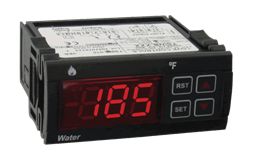Series TSWB and the Power Of Collaborative Teamwork
Series TSWB and the Power Of Collaborative Teamwork
For years, Dwyer has taken pride in manufacturing innovative products that have the ability and versatility to sell into multiple markets. At times, Dwyer makes products that are so versatile that not even all of the options are able to be utilized. This is one such example.

The Series TSWB line of temperature controllers was developed for the burner / boiler industry, to control the combustion of alternative sources. This market has been particularly strong in the United States, based on the steadily increasing rates of heating fuel costs, and the perennial threat of drab, cold winters. Since the topic of boilers has already been discussed, we’ll just recap by stating that this type of system burns alternative fuels (e.g. wood or corn) to heat water in a chamber, which is then cycled through radiators inside a building envelope; thus eliminating the need to heat water by combustion of fuel oil. With any successful movement, comes the call for regulation. We have multiple agency approvals for everything from mechanical pencils to toilet seats, to ensure that products be made with consumer and environmental safety in mind. So, when the EPA issued the goal to create “a new generation of lower-emitting fireplaces that burn cord wood”, they also created the inherent need for more precise emissions monitoring. This can be done by scrubbing the fumes as they exit a smoke stack, or by increasing the temperature in a burn box to reduce the amount of organic material in the exhaust. Since scrubbing the fumes creates back pressure, additional expense, and a planned maintenance schedule, most manufacturers have decided that increased temperature is the way to go. In order to increase the temperature of a fire, fuel and air levels need to be mixed appropriately. This is where the TSWB comes into play: the controller has the ability to monitor high set point temperature (maintaining the high temperature requirement for low emissions), low set point temperature (signaling when more fuel must be added to the controller),and low water level (emergency shut-off in the event that no water is present in the burn chamber, preventing explosion).
Working with a customer in Michigan, we sought out to employ all of the design features of the TSWB to meet the market demands created by the EPA. Despite all of the flexibility of the TSWB, only two of the outputs are able to be utilized at one time. This gives us three variables and two equations. With the service manual for the TSWB and a list of desired features from the customer in-hand, our engineers helped to develop a solution in the form of a wiring schematic that would incorporate the use of a simple external relay. The relay amounted to no more than $10 USD, but the savings that were provided to the customer by not having to determine their own wiring diagram were immeasurable.
The customer was able to find a local source for the relay component and was elated with the results that Dwyer had helped them achieve. Not only did the TSWB, with its custom wiring schematic, work flawlessly, but they found that the system was 5% more efficient than they had expected. Dwyer has now delivered more than 100 of the TSWB units to the customer in a span of roughly three months; and more importantly, built a sustained bond with an organization that sees Dwyer as more than just a supplier, but an ally toward the advancement of their business.
